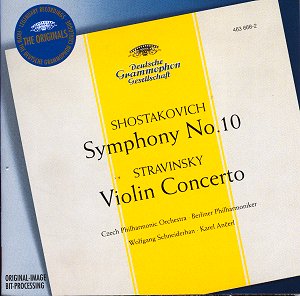This issue brings together two classic performances
from the Deutsche Grammophon catalogue which, so far as Iím aware, have
not been available for several years, and which, on the face of it,
have much in common. Two major works by twentieth century Russian composers,
written a mere twenty or so years apart, each with Ančerl
conducting. But one (the Stravinsky) is a very nice stereo, recorded
in a beautifully resonant acoustic; the other (the Shostakovich) is
an older mono which, though itís easy to adjust to, lacks weight and
range by the standards of only seven years later. The lush and
obviously Western-sounding Berlin Philharmonic is used for the (obviously
Westernised) Stravinsky; after which, the distinctive East European
sonority of the Czech Philharmonic comes as a (very appropriate) culture
shock. As for the music, the two pieces are poles apart: and I suspect
one composer had only superficial respect for the other.
Of course the Iron Curtain separates these scores very
strikingly. The Stravinsky was written in France, well into his period
of exile: and it is as neo-classical as any of his neo-classical music.
Perfectly crafted, it is brim-full of 18th century turns, ornaments
and scales, riddled with baroque concertante effects, and (in the two
central Arias) graced by gloriously vocal, diatonic music, the like
of which (one imagines) Bach would have been proud to have written.
The Shostakovich, on the other hand, is a semi-traditional symphony:
a truly Soviet piece which, characteristically for its composer, manages
to be both neo-Tchaikovskian and neo-Mahlerian. Written on a vast scale,
it brings together agonisingly personal soliloquies with brashly assertive
displays of pseudo-optimism.
Both performances are outstanding. Schneiderhan plays
the Stravinsky with extraordinary commitment: the outer movements are
superbly energetic, with not so much as a moment of insecurity, while
the divinely beautiful inner movements are played with lovely tone and
abundant emotion. The accompaniment is no accompaniment, of course:
in effect, the solo violinist belongs with
(and walks in and out of) the orchestra. Happily, the Berlin wind and
brass play with soloistic confidence, and Ančerl holds everything
together impressively. If you find some of the competition a little
too pure and restrained (like Sternís, with the composer
himself conducting?) this heart-stirring version will surely appeal
to you. But others may find it too Ďromanticí.
The Shostakovich symphony was a mere two years old
when this performance was taped. And there is something peculiarly and
compellingly immediate about this recording, which unfolds like a great
news story being reported Ďliveí, as it breaks. It belongs in the same
category as the more-or-less contemporary Mravinsky recordings of the
late Tchaikovsky symphonies with the Leningrad
Symphony Orchestra. Incredibly well-drilled, the Czech orchestra plays
with staggering virtuosity, most especially in the second movement,
which Ančerl moves along at a breathtaking speed. The rustic but
vibrant tonal quality of its wind and brass soloists (not unlike
their Leningrad counterparts, in fact) is just right in this kind of
music. Later performances have tended to take a more expansive view
of this symphony, most especially the first movement (where the drama
can be still more involving at a steadier pulse) and the
slow introduction to the finale. It could be argued that Ančerl
reduces the temperature of the music-making with his apparent impatience
to move on, and that even the scherzo would benefit in rhythmic impact
from holding back a little. Even so, the climaxes here have a
real sense of crisis: they are genuinely disturbing, as indeed they
should be.
I suppose there will be few collectors who buy this
as a one-and-only version. In which case, best regard this as a complement
to later DDD stereo recordings (such as Skrowaczewski, Jansons or Järvi)
and hear it for its very special qualities Ė its intensity, its urgency.
Thereís an overwhelming conviction in Ančerlís reading which the
rather limited sound quality cannot possibly disguise: itís truly authentic
Shostakovich.
Peter J Lawson
[NOTE This recording of the Shostakovich 10th symphony
is available in France with a different coupling.
Dimitri SHOSTAKOVICH Symphony
No. 10 in E Minor * Maurice RAVEL
Bolero ** Zoltan KODALY
Dances from Galanta **  Czech Philharmonic conducted by Karel Ancerl * RIAS Symphony Orchestra
Berlin conducted by Ferenc Fricsay ** recorded 1956 Prague *, Berlin
**.
Czech Philharmonic conducted by Karel Ancerl * RIAS Symphony Orchestra
Berlin conducted by Ferenc Fricsay ** recorded 1956 Prague *, Berlin
**.  DG 457 080-2 [76.17]
DG 457 080-2 [76.17]
Amazon.Fr
85,93 FF / EUR 13,10 [My copy into the UK
was £11.23 incl. p&p. LM] see
review


